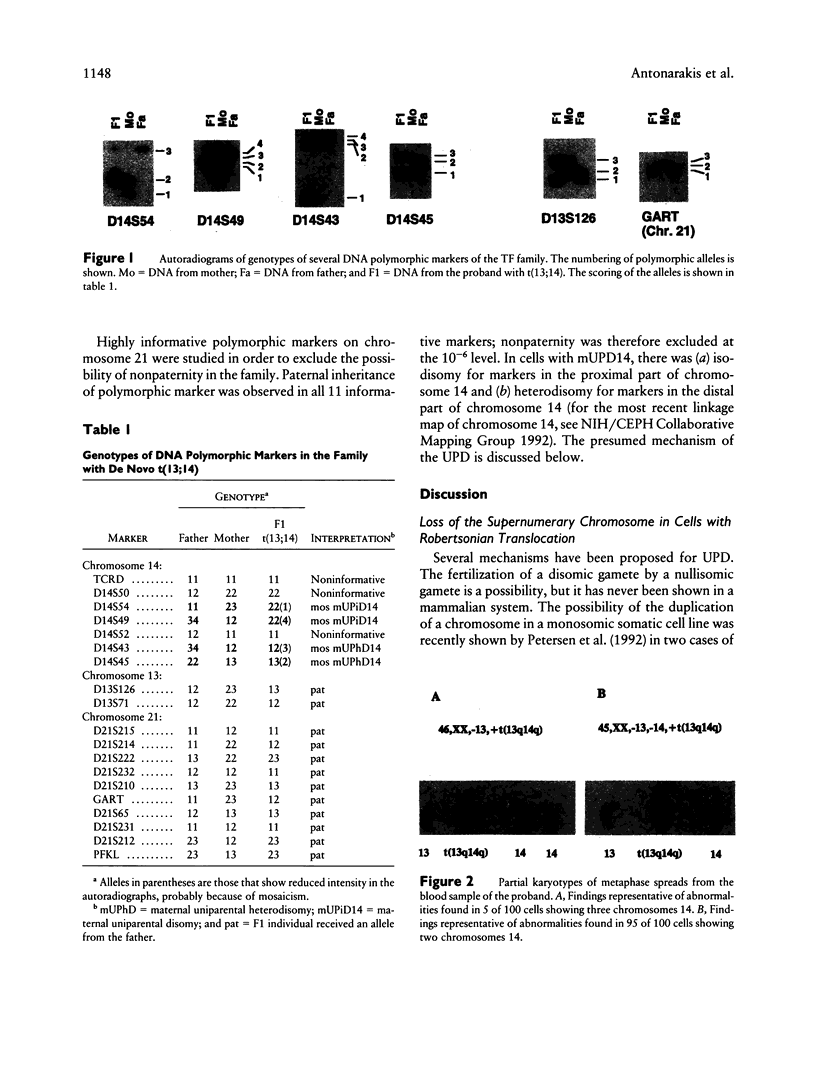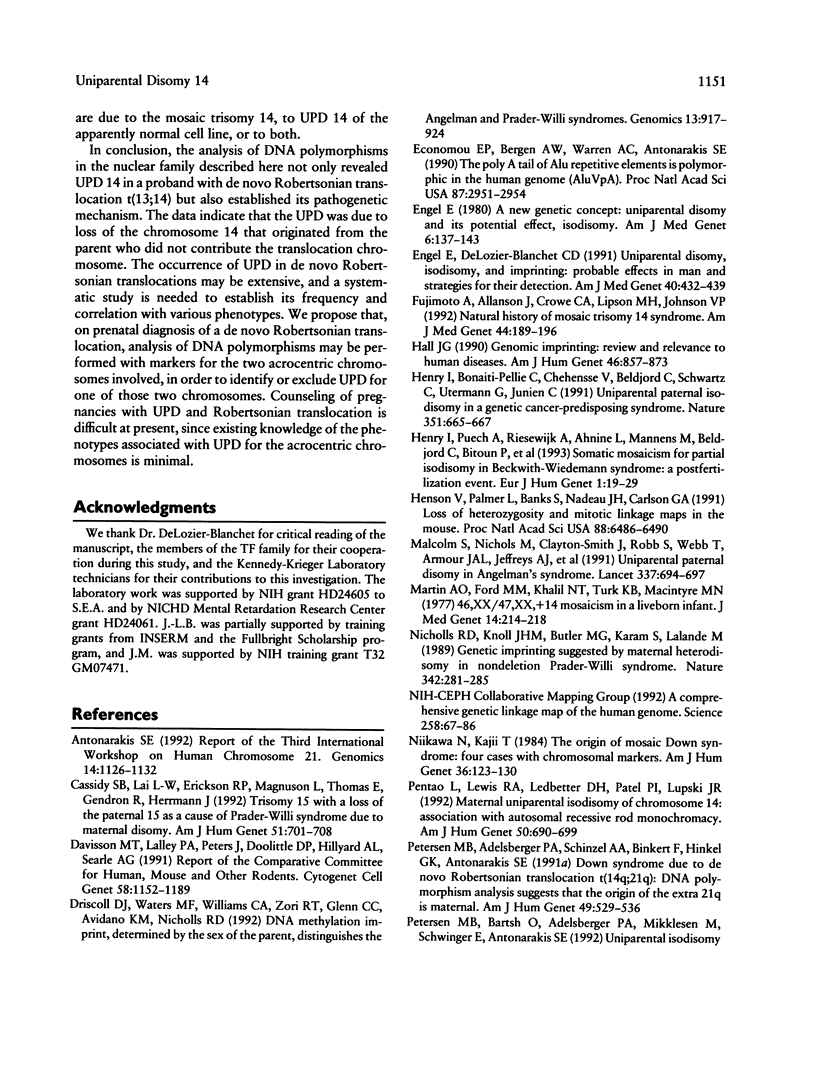Abstract
Uniparental disomy (UPD) for particular chromosomes is increasingly recognized as a cause of abnormal phenotypes in humans. We recently studied a 9-year-old female with a de novo Robertsonian translocation t(13;14), short stature, mild developmental delay, scoliosis, hyperextensible joints, hydrocephalus that resolved spontaneously during the first year of life, and hypercholesterolemia. To determine the parental origin of chromosomes 13 and 14 in the proband, we have studied the genotypes of DNA polymorphic markers due to (GT)n repeats in the patient and her parents' blood DNA. The genotypes of markers D14S43, D14S45, D14S49, and D14S54 indicated maternal UPD for chromosome 14. There was isodisomy for proximal markers and heterodisomy for distal markers, suggesting a recombination event on maternal chromosomes 14. In addition, DNA analysis first revealed--and subsequent cytogenetic analysis confirmed--that there was mosaic trisomy 14 in 5% of blood lymphocytes. There was normal (biparental) inheritance for chromosome 13, and there was no evidence of false paternity in genotypes of 11 highly polymorphic markers on human chromosome 21. Two cases of maternal UPD for chromosome 14 have previously been reported, one with a familial rob t(13;14) and the other with a t(14;14). There are several similarities among these patients, and a "maternal UPD chromosome 14 syndrome" is emerging; however, the contribution of the mosaic trisomy 14 to the phenotype cannot be evaluated. The study of de novo Robertsonian translocations of the type reported here should reveal both the extent of UPD in these events and the contribution of particular chromosomes involved in certain phenotypes.
Full text
PDF







Images in this article
Selected References
These references are in PubMed. This may not be the complete list of references from this article.
- Antonarakis S. E. Third International Workshop on Human Chromosome 21. Genomics. 1992 Dec;14(4):1126–1132. doi: 10.1016/s0888-7543(05)80148-x. [DOI] [PubMed] [Google Scholar]
- Cassidy S. B., Lai L. W., Erickson R. P., Magnuson L., Thomas E., Gendron R., Herrmann J. Trisomy 15 with loss of the paternal 15 as a cause of Prader-Willi syndrome due to maternal disomy. Am J Hum Genet. 1992 Oct;51(4):701–708. [PMC free article] [PubMed] [Google Scholar]
- Driscoll D. J., Waters M. F., Williams C. A., Zori R. T., Glenn C. C., Avidano K. M., Nicholls R. D. A DNA methylation imprint, determined by the sex of the parent, distinguishes the Angelman and Prader-Willi syndromes. Genomics. 1992 Aug;13(4):917–924. doi: 10.1016/0888-7543(92)90001-9. [DOI] [PubMed] [Google Scholar]
- Economou E. P., Bergen A. W., Warren A. C., Antonarakis S. E. The polydeoxyadenylate tract of Alu repetitive elements is polymorphic in the human genome. Proc Natl Acad Sci U S A. 1990 Apr;87(8):2951–2954. doi: 10.1073/pnas.87.8.2951. [DOI] [PMC free article] [PubMed] [Google Scholar]
- Engel E. A new genetic concept: uniparental disomy and its potential effect, isodisomy. Am J Med Genet. 1980;6(2):137–143. doi: 10.1002/ajmg.1320060207. [DOI] [PubMed] [Google Scholar]
- Engel E., DeLozier-Blanchet C. D. Uniparental disomy, isodisomy, and imprinting: probable effects in man and strategies for their detection. Am J Med Genet. 1991 Sep 15;40(4):432–439. doi: 10.1002/ajmg.1320400411. [DOI] [PubMed] [Google Scholar]
- Fujimoto A., Allanson J., Crowe C. A., Lipson M. H., Johnson V. P. Natural history of mosaic trisomy 14 syndrome. Am J Med Genet. 1992 Sep 15;44(2):189–196. doi: 10.1002/ajmg.1320440214. [DOI] [PubMed] [Google Scholar]
- Hall J. G. Genomic imprinting: review and relevance to human diseases. Am J Hum Genet. 1990 May;46(5):857–873. [PMC free article] [PubMed] [Google Scholar]
- Henry I., Bonaiti-Pellié C., Chehensse V., Beldjord C., Schwartz C., Utermann G., Junien C. Uniparental paternal disomy in a genetic cancer-predisposing syndrome. Nature. 1991 Jun 20;351(6328):665–667. doi: 10.1038/351665a0. [DOI] [PubMed] [Google Scholar]
- Henry I., Puech A., Riesewijk A., Ahnine L., Mannens M., Beldjord C., Bitoun P., Tournade M. F., Landrieu P., Junien C. Somatic mosaicism for partial paternal isodisomy in Wiedemann-Beckwith syndrome: a post-fertilization event. Eur J Hum Genet. 1993;1(1):19–29. doi: 10.1159/000472384. [DOI] [PubMed] [Google Scholar]
- Henson V., Palmer L., Banks S., Nadeau J. H., Carlson G. A. Loss of heterozygosity and mitotic linkage maps in the mouse. Proc Natl Acad Sci U S A. 1991 Aug 1;88(15):6486–6490. doi: 10.1073/pnas.88.15.6486. [DOI] [PMC free article] [PubMed] [Google Scholar]
- Malcolm S., Clayton-Smith J., Nichols M., Robb S., Webb T., Armour J. A., Jeffreys A. J., Pembrey M. E. Uniparental paternal disomy in Angelman's syndrome. Lancet. 1991 Mar 23;337(8743):694–697. doi: 10.1016/0140-6736(91)90278-w. [DOI] [PubMed] [Google Scholar]
- Martin A. O., Ford M. M., Khalil N. T., Turk K. B., Macintyre M. N. 46,XX/47XX, + 14 mosaicism in a liveborn infant. J Med Genet. 1977 Jun;14(3):214–218. doi: 10.1136/jmg.14.3.214. [DOI] [PMC free article] [PubMed] [Google Scholar]
- Nicholls R. D., Knoll J. H., Butler M. G., Karam S., Lalande M. Genetic imprinting suggested by maternal heterodisomy in nondeletion Prader-Willi syndrome. Nature. 1989 Nov 16;342(6247):281–285. doi: 10.1038/342281a0. [DOI] [PMC free article] [PubMed] [Google Scholar]
- Niikawa N., Kajii T. The origin of mosaic Down syndrome: four cases with chromosome markers. Am J Hum Genet. 1984 Jan;36(1):123–130. [PMC free article] [PubMed] [Google Scholar]
- Pentao L., Lewis R. A., Ledbetter D. H., Patel P. I., Lupski J. R. Maternal uniparental isodisomy of chromosome 14: association with autosomal recessive rod monochromacy. Am J Hum Genet. 1992 Apr;50(4):690–699. [PMC free article] [PubMed] [Google Scholar]
- Petersen M. B., Adelsberger P. A., Schinzel A. A., Binkert F., Hinkel G. K., Antonarakis S. E. Down syndrome due to de novo Robertsonian translocation t(14q;21q): DNA polymorphism analysis suggests that the origin of the extra 21q is maternal. Am J Hum Genet. 1991 Sep;49(3):529–536. [PMC free article] [PubMed] [Google Scholar]
- Petersen M. B., Bartsch O., Adelsberger P. A., Mikkelsen M., Schwinger E., Antonarakis S. E. Uniparental isodisomy due to duplication of chromosome 21 occurring in somatic cells monosomic for chromosome 21. Genomics. 1992 Jun;13(2):269–274. doi: 10.1016/0888-7543(92)90242-k. [DOI] [PubMed] [Google Scholar]
- Petersen M. B., Schinzel A. A., Binkert F., Tranebjaerg L., Mikkelsen M., Collins F. A., Economou E. P., Antonarakis S. E. Use of short sequence repeat DNA polymorphisms after PCR amplification to detect the parental origin of the additional chromosome 21 in Down syndrome. Am J Hum Genet. 1991 Jan;48(1):65–71. [PMC free article] [PubMed] [Google Scholar]
- Petersen M. B., Slaugenhaupt S. A., Lewis J. G., Warren A. C., Chakravarti A., Antonarakis S. E. A genetic linkage map of 27 markers on human chromosome 21. Genomics. 1991 Mar;9(3):407–419. doi: 10.1016/0888-7543(91)90406-5. [DOI] [PubMed] [Google Scholar]
- Petersen M. B., Vejerslev L. O., Beck B. Trisomy 14 mosaicism in a 2 year old girl. J Med Genet. 1986 Feb;23(1):86–88. doi: 10.1136/jmg.23.1.86. [DOI] [PMC free article] [PubMed] [Google Scholar]
- Purvis-Smith S. G., Saville T., Manass S., Yip M. Y., Lam-Po-Tang P. R., Duffy B., Johnston H., Leigh D., McDonald B. Uniparental disomy 15 resulting from "correction" of an initial trisomy 15. Am J Hum Genet. 1992 Jun;50(6):1348–1350. [PMC free article] [PubMed] [Google Scholar]
- Robinson W. P., Bottani A., Xie Y. G., Balakrishman J., Binkert F., Mächler M., Prader A., Schinzel A. Molecular, cytogenetic, and clinical investigations of Prader-Willi syndrome patients. Am J Hum Genet. 1991 Dec;49(6):1219–1234. [PMC free article] [PubMed] [Google Scholar]
- Roeder G. S., Stewart S. E. Mitotic recombination in yeast. Trends Genet. 1988 Sep;4(9):263–267. doi: 10.1016/0168-9525(88)90034-0. [DOI] [PubMed] [Google Scholar]
- Spence J. E., Perciaccante R. G., Greig G. M., Willard H. F., Ledbetter D. H., Hejtmancik J. F., Pollack M. S., O'Brien W. E., Beaudet A. L. Uniparental disomy as a mechanism for human genetic disease. Am J Hum Genet. 1988 Feb;42(2):217–226. [PMC free article] [PubMed] [Google Scholar]
- Temple I. K., Cockwell A., Hassold T., Pettay D., Jacobs P. Maternal uniparental disomy for chromosome 14. J Med Genet. 1991 Aug;28(8):511–514. doi: 10.1136/jmg.28.8.511. [DOI] [PMC free article] [PubMed] [Google Scholar]
- Voss R., Ben-Simon E., Avital A., Godfrey S., Zlotogora J., Dagan J., Tikochinski Y., Hillel J. Isodisomy of chromosome 7 in a patient with cystic fibrosis: could uniparental disomy be common in humans? Am J Hum Genet. 1989 Sep;45(3):373–380. [PMC free article] [PubMed] [Google Scholar]
- Wang J. C., Passage M. B., Yen P. H., Shapiro L. J., Mohandas T. K. Uniparental heterodisomy for chromosome 14 in a phenotypically abnormal familial balanced 13/14 Robertsonian translocation carrier. Am J Hum Genet. 1991 Jun;48(6):1069–1074. [PMC free article] [PubMed] [Google Scholar]
- Wang Z., Weber J. L. Continuous linkage map of human chromosome 14 short tandem repeat polymorphisms. Genomics. 1992 Jul;13(3):532–536. doi: 10.1016/0888-7543(92)90121-8. [DOI] [PubMed] [Google Scholar]
- Weber J. L., May P. E. Abundant class of human DNA polymorphisms which can be typed using the polymerase chain reaction. Am J Hum Genet. 1989 Mar;44(3):388–396. [PMC free article] [PubMed] [Google Scholar]
- Welch T. R., Beischel L. S., Choi E., Balakrishnan K., Bishof N. A. Uniparental isodisomy 6 associated with deficiency of the fourth component of complement. J Clin Invest. 1990 Aug;86(2):675–678. doi: 10.1172/JCI114760. [DOI] [PMC free article] [PubMed] [Google Scholar]




